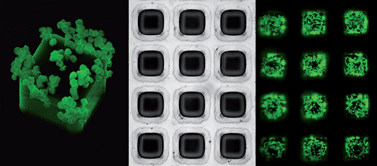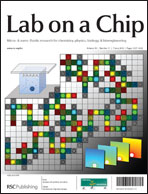Handling microorganisms in high throughput and their deployment into miniaturized platforms presents significant challenges. Contact printing can be used to create dense arrays of viable microorganisms. Such “living arrays”, potentially with multiple identical replicates, are useful in the selection of improved industrial microorganisms, screening antimicrobials, clinical diagnostics, strain storage, and for research into microbial genetics. A high throughput method to print microorganisms at high density was devised, employing a microscope and a stamp with a massive array of PDMS pins. Viable bacteria (Lactobacillus plantarum, Esherichia coli), yeast (Candida albicans) and fungal spores (Aspergillus fumigatus) were deposited onto porous aluminium oxide (PAO) using arrays of pins with areas from 5 × 5 to 20 × 20 μm. Printing onto PAO with up to 8100 pins of 20 × 20 μm area with 3 replicates was achieved. Printing with up to 200 pins onto PAO culture chips (divided into 40 × 40 μm culture areas) allowed inoculation followed by effective segregation of microcolonies during outgrowth. Additionally, it was possible to print mixtures of C. albicans and spores of A. fumigatus with a degree of selectivity by capture onto a chemically modified PAO surface. High resolution printing of microorganisms within segregated compartments and on functionalized PAO surfaces has significant advantages over what is possible on semi-solid surfaces such as agar.

You have access to this article
 Please wait while we load your content...
Something went wrong. Try again?
Please wait while we load your content...
Something went wrong. Try again?


 Please wait while we load your content...
Please wait while we load your content...